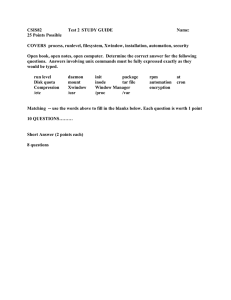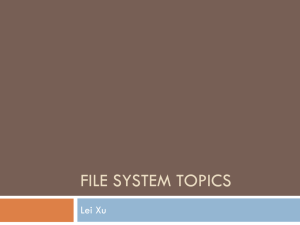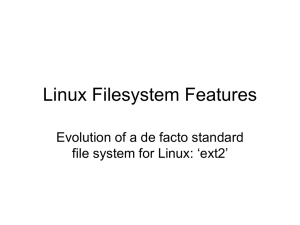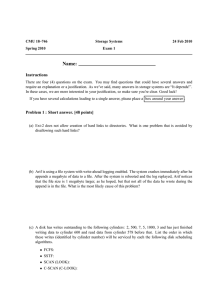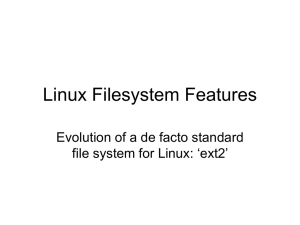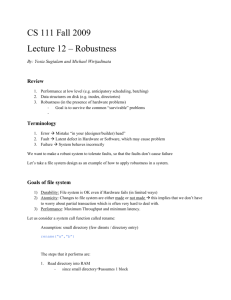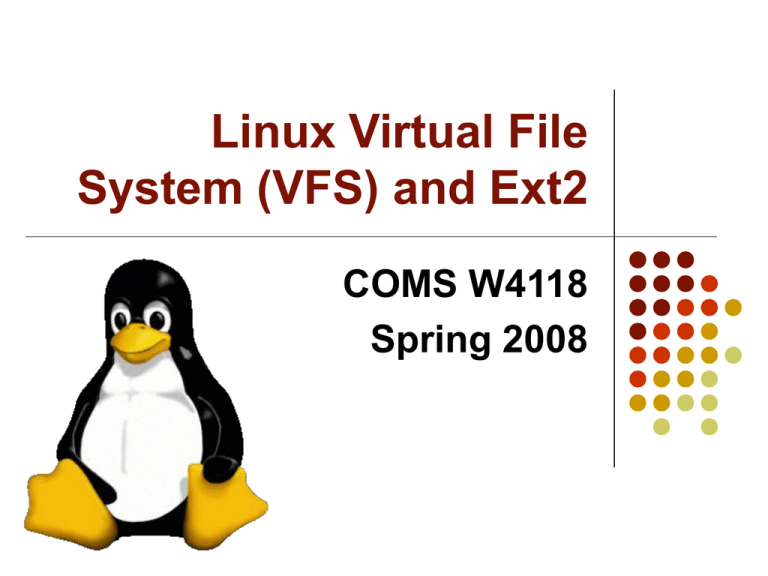
Linux Virtual File
System (VFS) and Ext2
COMS W4118
Spring 2008
File Systems
old days – "the" filesystem!
now – many filesystem types, many instances
need to copy file from NTFS to Ext3
original motivation – NFS support (Sun)
idea – filesystem op abstraction layer (VFS)
Virtual File System (aka Virtual Filesystem Switch)
File-related ops determine filesystem type
Dispatch (via function pointers) filesystem-specific op
2
File System Types
lots and lots of filesystem types!
examples
standard: Ext2, ufs (Solaris), svfs (SysV), ffs (BSD)
network: RFS, NFS, Andrew, Coda, Samba, Novell
journaling: Ext3, Veritas, ReiserFS, XFS, JFS
media-specific: jffs, ISO9660 (cd), UDF (dvd)
special: /proc, tmpfs, sockfs, etc.
proprietary
2.6 has nearly 100 in the standard kernel tree
MSDOS, VFAT, NTFS, Mac, Amiga, etc.
new generation for Linux
Ext3, ReiserFS, XFS, JFS
3
Linux File System Model
basically UNIX file semantics
File systems are mounted at various points
Files identified by device inode numbers
VFS layer just dispatches to fs-specific functions
libc read() -> sys_read()
what type of filesystem does this file belong to?
call filesystem (fs) specific read function
maintained in open file object (file)
example: file->f_op->read(…)
similar to device abstraction model in UNIX
4
VFS System Calls
fundamental UNIX abstractions
files (everything is a file)
ex: /dev/ttyS0 – device as a file
ex: /proc/123 – process as a file
processes
users
lots of syscalls related to files! (~100)
most dispatch to filesystem-specific calls
some require no filesystem action
example: lseek(pos) – change position in file
others have default VFS implementations
5
VFS System Calls (cont.)
filesystem ops – mounting, info, flushing, chroot, pivot_root
directory ops – chdir, getcwd, link, unlink, rename, symlink
file ops – open/close, (p)read(v)/(p)write(v), seek, truncate, dup
fcntl, creat,
inode ops – stat, permissions, chmod, chown
memory mapping files – mmap, munmap, madvise, mlock
wait for input – poll, select
flushing – sync, fsync, msync, fdatasync
file locking – flock
6
VFS-related Task Fields
task_struct fields
fs – includes root, pwd
pointers to dentries
files – includes file descriptor array fd[]
pointers to open file objects
7
Big Four Data Structures
struct file
information about an open file
includes current position (file pointer)
struct dentry
information about a directory entry
includes name + inode#
struct inode
unique descriptor of a file or directory
contains permissions, timestamps, block map (data)
inode#: integer (unique per mounted filesystem)
struct superblock
descriptor of a mounted filesystem
8
Two More Data Structures
struct file_system_type
name of file system
pointer to implementing module
including how to read a superblock
On module load, you call register_file_system and pass a pointer
to this structure
struct vfsmount
Represents a mounted instance of a particular file system
One super block can be mounted in two places, with different
covering sub mounts
Thus lookup requires parent dentry and a vfsmount
9
Data Structure Relationships
task_struct
inode cache
inode
inode
inode
fds
open
file
object
open
file
object
open
file
object
superblock
dentry
dentry
dentry
dentry
dentry
disk
dentry cache
10
Sharing Data Structures
calling dup() –
opening the same file twice –
shares dentries
opening same file via different hard links –
shares open file objects
example: 2>&1
shares inodes
mounting same filesystem on different dirs –
shares superblocks
11
Superblock
mounted filesystem descriptor
usually first block on disk (after boot block)
copied into (similar) memory structure on mount
distinction: disk superblock vs memory superblock
dirty bit (s_dirt), copied to disk frequently
important fields
s_dev, s_bdev – device, device-driver
s_blocksize, s_maxbytes, s_type
s_flags, s_magic, s_count, s_root, s_dquot
s_dirty – dirty inodes for this filesystem
s_op – superblock operations
u – filesystem specific data
12
Superblock Operations
filesystem-specific operations
read/write/clear/delete inode
write_super, put_super (release)
no get_super()! that lives in file_system_type descriptor
write_super_lockfs, unlockfs, statfs
file_handle ops (NFS-related)
show_options
13
Inode
"index" node – unique file or directory descriptor
meta-data: permissions, owner, timestamps, size, link
count
data: pointers to disk blocks containing actual data
data pointers are "indices" into file contents (hence "inode")
inode # - unique integer (per-mounted filesystem)
what about names and paths?
high-level fluff on top of a "flat-filesystem"
implemented by directory files (directories)
directory contents: name + inode
14
File Links
UNIX link semantics
hard links – multiple dir entries with same inode #
equal status; first is not "real" entry
file deleted when link count goes to 0
restrictions
can't hard link to directories (avoids cycles)
or across filesystems
soft (symbolic) links – little files with pathnames
just aliases for another pathname
no restrictions, cycles possible, dangling links possible
15
Inode Fields
large struct (~50 fields)
important fields
i_sb, i_ino (number), i_nlink (link count)
metadata: i_mode, i_uid, i_gid, i_size, i_times
i_flock (lock list), i_wait (waitq – for blocking ops)
linkage: i_hash, i_list, i_dentry (aliases)
i_op (inode ops), i_fop (default file ops)
u (filesystem specific data – includes block map!)
16
Inode Operations
create – new inode for regular file
link/unlink/rename –
add/remove/modify dir entry
symlink, readlink, follow_link – soft link ops
mkdir/rmdir – new inode for directory file
mknod – new inode for device file
truncate – modify file size
permission – check access permissions
17
(Open) File Object
struct file (usual variable name - filp)
file descriptor (small ints)
association between file and process
no disk representation
created for each open (multiple possible, even same file)
most important info: file pointer
index into array of pointers to open file objects
file object states
unused (memory cache + root reserve (10))
get_empty_filp()
inuse (per-superblock lists)
system-wide max on open file objects (~8K)
/proc/sys/fs/file-max
18
File Object Fields
important fields
f_dentry (directory entry of file)
f_vfsmnt (fs mount point)
f_op (fs-specific functions – table of function pointers)
f_count, f_flags, f_mode (r/w, permissions, etc.)
f_pos (current position – file pointer)
info for read-ahead (more later)
f_uid, f_gid, f_owner
f_version (for consistency maintenance)
private_data (fs-specific data)
19
File Object Operations
f_op field – table of function pointers
copied from inode (i_fop) initially (fs-specific)
possible to change to customize (per-open)
device-drivers do some tricks like this sometimes
important operations
llseek(), read(), write(), readdir(), poll()
ioctl() – "wildcard" function for per-fs semantics
mmap(), open(), flush(), release(), fsync()
fasync() – turn on/off asynchronous i/o notifications
lock() – file-locks (more later)
readv(), writev() – "scatter/gather i/o"
read/write with discontiguous buffers (e.g. packets)
sendpage() – page-optimized socket transfer
20
Dentry
abstraction of directory entry
directory api: dentry iterators
ex: line from ls -l
either files (hard links) or soft links or subdirectories
every dentry has a parent dentry (except root)
sibling dentries – other entries in the same directory
posix: opendir(), readdir(), scandir(), seekdir(), rewinddir()
syscall: getdents()
why an abstraction?
UNIX: directories are really files with directory "records"
MSDOS, etc.: directory is just a big table on disk (FAT)
no such thing as subdirectories!
just fields in table (file->parentdir), (dir->parentdir)
21
Dentry (continued)
not-disk based (no dirty bit)
dentry_cache – slab cache
important fields
d_name (qstr), d_count, d_flags
d_inode – associated inode
d_parent – parent dentry
d_child – siblings list
d_subdirs – my children (if i'm a subdirectory)
d_alias – other names (links) for the same object (inode)?
d_lru – unused state linkage
d_op – dentry operations (function pointer table)
d_fsdata – filesystem-specific data
22
Dentry Cache
very important cache for filesystem performance
dentry cache "controls" inode cache
every file access causes multiple dentry accesses!
example: /tmp/foo
dentries for "/", "/tmp", "/tmp/foo" (path components)
inodes released only when dentry is released
dentry cache accessed via hash table
hash(dir, filename) -> dentry
23
Dentry Cache (continued)
dentry states
free (not valid; maintained by slab cache)
in-use (associated with valid open inode)
unused (valid but not being used; LRU list)
negative (file that does not exist)
dentry ops
just a few, mostly default actions
ex: d_compare(dir, name1, name2)
case-insensitive for MSDOS
24
Process-related Files
current->fs (fs_struct)
root (for chroot jails)
pwd
umask (default file permissions)
current->files (files_struct)
fd[] (file descriptor array – pointers to file objects)
0, 1, 2 – stdin, stdout, stderr
originally 32, growable to 1,024 (RLIMIT_NOFILE)
complex structure for growing … see book
close_on_exec memory (bitmap)
open files normally inherited across exec
25
Filesystem Types
Linux must "know about" filesystem before mount
multiple (mounted) instances of each type possible
special (virtual) filesystems (like /proc)
structuring technique to touch kernel data
examples:
/proc, /dev (devfs)
sockfs, pipefs, tmpfs, rootfs, shmfs
associated with fictitious block device (major# 0)
minor# distinguishes special filesystem types
26
Registering a Filesystem Type
must register before mount
register_filesystem() / unregister_filesystem
static (compile-time) or dynamic (modules)
adds file_system_type object to linked-list
file_systems (head; kernel global variable)
file_systems_lock (rw spinlock to protect list)
file_system_type descriptor
name, flags, pointer to implementing module
list of superblocks (mounted instances)
read_super() – pointer to method for reading superblock
most important thing! filesystem specific
27
Data Structure Relationships (2)
open
file
object
f_dentry
dentry
d_subdirs
open
file
object
dentry
dentry
inode
inode
dentry inode
┴
open
file
object
d_inode
d_subdirs
d_parent
i_sb
superblock
d_sb
i_dentries
28
Ext2
“Standard” Linux File System
Uses FFS like layout
Previously it was the most commonly used
Serves as a basis for Ext3 which adds journaling
Each file system is composed of identical block groups
Allocation is designed to improve locality
Inodes contain pointers (32 bits) to blocks
Direct, Indirect, Double Indirect, Triple Indirect
Maximum file size: 4.1TB (4K Blocks)
Maximum file system size: 16TB (4K Blocks)
29
Ext2 Disk Layout
Files in the same directory are stored in the
same block group
Files in different directories are spread
among the block groups
30
Picture from Tanenbaum, Modern Operating Systems 3 e, (c) 2008 Prentice-Hall, Inc. All rights reserved. 0-13-6006639
Block Addressing in Ext2
Twelve “direct” blocks
Inode
Data
Data
Block
Data
Block
Block
BLKSIZE/4
Indirect
Blocks
Indirect
Blocks
(BLKSIZE/4)2
Double
Indirect
Indirect
Blocks
(BLKSIZE/4)3
Triple
Indirect
Double
Indirect
Indirect
Blocks
Indirect
Blocks
Data
Data
Block
Data
Block
Block
Data
Data
Block
Data
Block
Block
Data
Data
Block
Data
Block
Block
Data
Data
Block
Data
Block
Block
Data
Data
Block
Data
Block
Block
Picture from Tanenbaum, Modern Operating Systems 3 e, (c) 2008 Prentice-Hall, Inc. All rights reserved. 0-13-6006639
31
Ext2 Directory Structure
(a) A Linux directory with three files. (b) The same directory
after the file voluminous has been removed.
32
Picture from Tanenbaum, Modern Operating Systems 3 e, (c) 2008 Prentice-Hall, Inc. All rights reserved. 0-13-6006639

